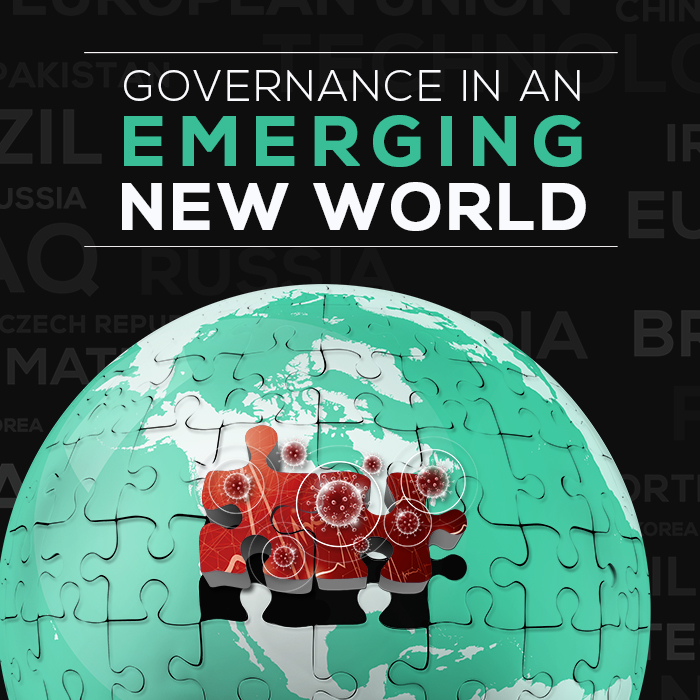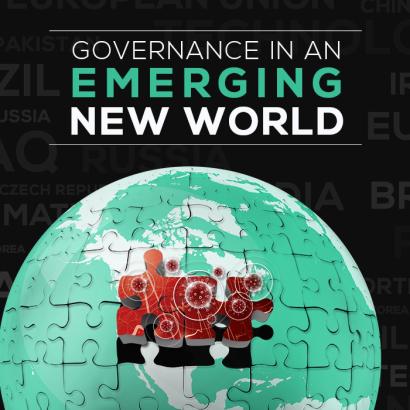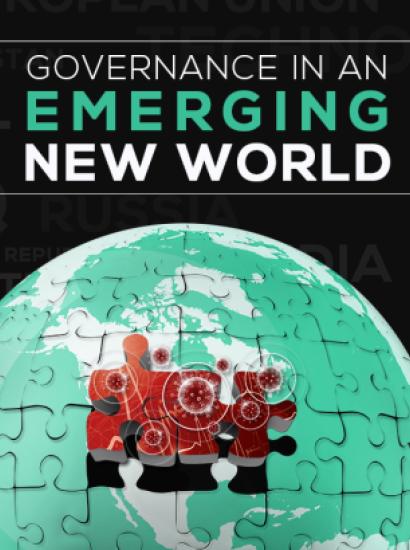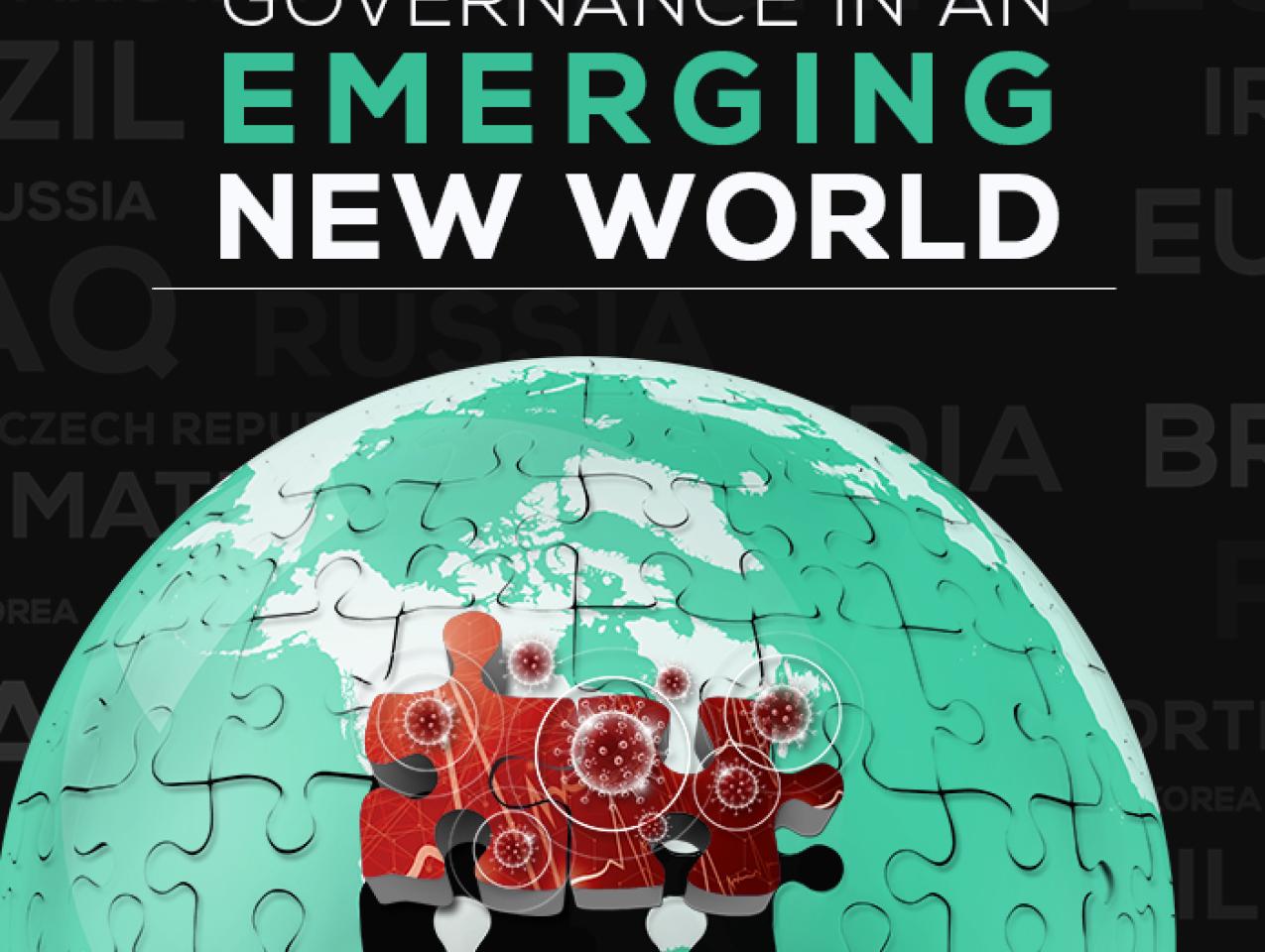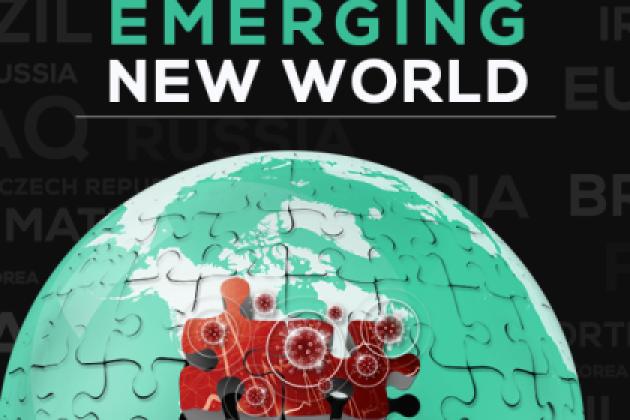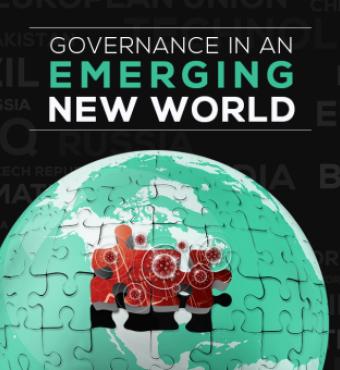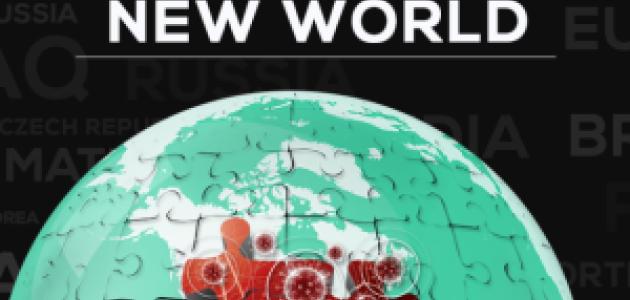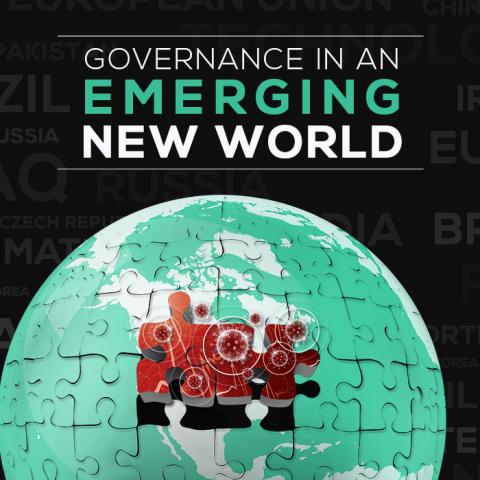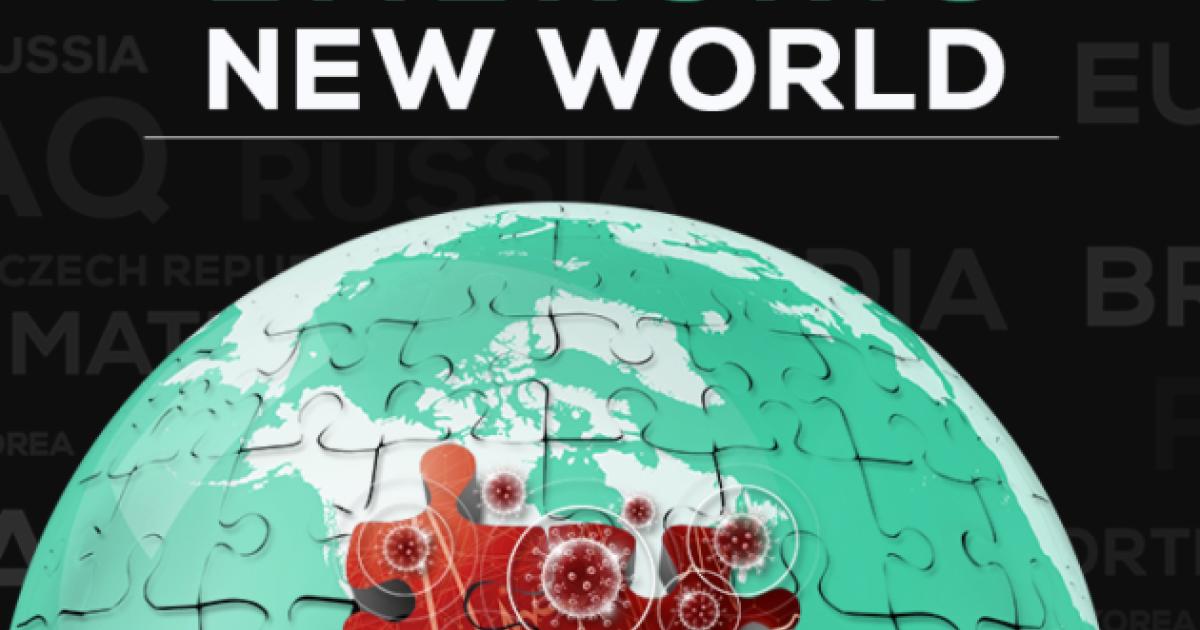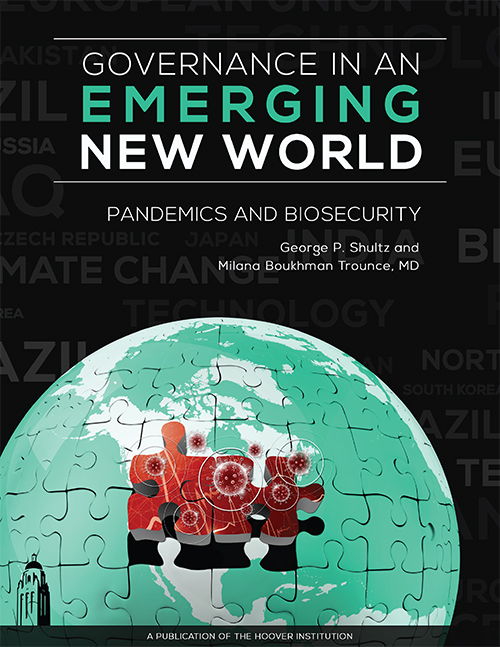- Energy & Environment
Foreword
On April 8, 2019, we gathered around the circular table in the Annenberg Conference Room at the Hoover Institution for another discussion from our research project on Governance in an Emerging New World. This session was led by Dr. Lucy Shapiro, a professor of biology at the Stanford University School of Medicine.
One featured speaker was Dr. Milana Boukhman Trounce. One of Hoover’s great assets is our ability to draw on the wealth of expertise surrounding us across the Stanford campus, and our interaction with Dr. Trounce exemplifies that. A Stanford professor and emergency medicine physician, policy scholars here were introduced to Dr. Trounce through an even earlier cross-disciplinary Hoover policy panel on the threat of pandemics, organized by Hoover National Security Affairs Fellow Conny Arvis, representing the US Department of State. For our 2019 Governance Project discussion, Dr. Trounce presented a paper on potential pandemics. She described in detail in her paper how “the threat of infectious disease is making a comeback. Unfortunately, at this point, we are ill equipped to deal with a number of scenarios, particularly those involving large-scale infectious disease outbreaks—pandemics.” She explained how human activities, including increased contact between humans and wild animals and global transportation networks, have increased the threat of new infectious diseases. She explained why drugs for the treatment of a new disease such as this and vaccines to prevent its spread would not be available in time to prevent a public health crisis. The principal countermeasures would be the same public health measures that have been used for centuries—isolation and quarantine.
We learned that the word “quarantine” is derived from an Italian term for the forty days that all ships were required to be isolated before passengers and crew could go ashore during the fourteenth-century Black Death plague epidemic. We learned about “social-distancing” measures, such as closing schools, public gatherings, businesses, and transport, and the possibility that internet commerce might facilitate implementation of isolation and quarantine. We learned that rapid diagnostic testing, if available, might help a lot. Later in the day, we heard from Stephen Quake, a professor of bioengineering at Stanford, about the potential of modern gene-sequencing technology to rapidly recognize the causes of infectious disease outbreaks.
Overall, the panelists argued that “the public sector is not sufficiently preparing for this.” While local public health departments have protocols, do drills, and receive guidance from the federal Centers for Disease Control and Prevention (CDC), “there are too many cooks in the kitchen.” A large-scale disease outbreak is not just a medical event but also one of public safety and security: “It’s chaos every time, and it is always reactive.” Looking at how warehousing and logistics technologies are developing, panelists considered how the US private sector might end up delivering many needed services in such an outbreak, and the market incentives and coordination that governments could consider to help enable that.
In response, Dr. Shapiro observed, “If you don’t push the boundaries of understanding this world that we are living in . . . without new kinds of understandings of how living beings, living organisms, can survive changes in their environment—we are being, if not short-sighted, then we are being criminal.”
One year later, project participants found themselves discussing pandemics one again, but not in a circle around Hoover’s Annenberg Conference Room on Stanford campus. Instead, we were all in our own squares, meeting virtually over online videoconferencing, each discussant in his or her spare bedroom—three months after a novel coronavirus became capable of infecting and spreading among humans in Wuhan. The potential threat was known, but we were not prepared for it when it became real.
An early retrospective of the US governance and civil society response to the COVID-19 pandemic of 2020 changes little from these warnings. It has simply made them clearer. We understand that political realities make proactivity—fully preparing for every small-chance, large-impact risk ahead of time—infeasible. No one celebrates the mitigation of the outcome that never occurred. One could say that the American way of dealing with the problem of prioritization is instead to react, swiftly and effectively, to the reality that has been made present to everyone. The whole-of-society approach to the 9/11 attacks exemplifies this sort of mobilization. But the COVID-19 pandemic calls that approach into question for the sorts of risks we see coming over the hinge of history and into the rest of the century: though small circles of experts knew exactly how the problems of a pandemic were likely to unfold, their technical foresight described a scenario so foreign to many of our institutions that once it actually happened, attempts to respond to an unrolling crisis fell flat. It took too long for them to internalize the novel nature of the crisis they faced. This was true across many organs of government. And it highlights the need to not just better prepare for pandemics but better prepare to react to anything, and to be flexible, so as to effectively function while under duress.
The virus shows that we are part of an interconnected world. And a pandemic is a clear example of a problem whose solution would benefit greatly from international cooperation and US leadership. The global response to COVID-19 could have been more effective with better international cooperation—and better US leadership. This is a recurring theme. International cooperation is part of the solution to the transformational challenges before us, including advancing technology, changing demographics, large-scale migration, global warming, and nuclear proliferation, not to mention the potential for infectious diseases far more lethal than COVID-19. Knowledge can lead to assessment of risk and appropriate preparations, and the following (unfortunately needed) sequel to Dr. Trounce’s earlier analysis points to steps that we can still take today for a better American recovery from this pandemic—and resilience against other health crises that are sure to come. Informed US leadership here is crucial at this time in our history.
George P. Shultz1
* * *
The COVID-19 pandemic shook the world and made humans’ vulnerability to infectious organisms apparent to all. When we wrote on potential pandemics in April 2019, as part of Hoover’s Governance in an Emerging New World publication series, the notion of a pandemic crippling society and spurring lockdowns and social distancing all over our nation and in much of the world seemed fantastical, something from a hundred years ago—which it was.2 The last time there were such sweeping infection-control measures in the United States was during the Spanish flu pandemic of 1918.
Yet what has transpired over the past few months followed a pattern remarkably similar to numerous other infectious-disease outbreaks. As such, our views on the management of pandemics, as discussed in the spring of 2019, remain unchanged. We will therefore revisit those ideas in light of the COVID-19 pandemic.
The Increasing Threat of Infectious Disease
Not only is our vulnerability to infectious disease not a new phenomenon. Throughout human history, it has in fact been the most frequent cause of human death. More people have died from infectious disease than from any kind of violence, including war, by at least one order of magnitude.
Infectious organisms have destabilized societies and governments, determined the outcome of wars, and otherwise shaped history. Europe was not the same after over half its population, by some estimates, was wiped out by bubonic plague in the fourteenth century. The course of American history, too, might have been quite different had 90 percent of the native populations not succumbed to the viruses brought by Europeans. Moreover, more people died from the Spanish influenza pandemic of 1918 than in the fighting in World War I. In more recent history, the destabilization due to the Ebola virus outbreak in West Africa caused the United Nations Security Council to declare it a “threat to international peace and security” in September 2014. It was the first resolution of the Security Council to deal with a public health crisis.
Now, we are witnessing the disruption of societies across the world brought on by SARS-CoV-2—the virus responsible for COVID-19. Given the numbers of lives lost in past infectious disease outbreaks, dedicating a level of effort and resources to fighting this pandemic similar to what we expend to win a war seems appropriate.
Although the twentieth century saw a retreat of infectious disease due to the advent of antibiotics, the notion of our species “conquering” them is misleading.
Why, especially now? Since the 1980s, we have seen a threefold increase in the number of global epidemics. Globalization, urbanization, the increased pace of commerce, climate change, and other factors enable viruses to spread faster across the world than ever before, and organisms that historically caused relatively small outbreaks are now able to launch epidemics.
For example, there were more than twenty Ebola outbreaks from 1976 to 2014. They were limited to either one or a cluster of villages in Africa. By contrast, the outbreak of 2015 claimed tens of thousands of lives all across West Africa and terrorized the entire world—the largest outbreak caused by a viral hemorrhagic fever virus in history. Other novel coronavirus outbreaks such as MERS and SARS have been significantly smaller, and coronaviruses causing relatively mild symptoms commonly circulate in human populations. Yet, in recent history, we have seen new types of pathogens causing damage of increasingly ominous proportions. What is driving that, besides urbanization and globalization?
Greater human encroachment on wild animal habitats, climate change, and different patterns of land use have resulted in closer contact between wild animal populations and humans. That increases the risk of viruses moving from animals to human beings. And that matters because most infectious disease outbreaks, including pandemics, are caused by viruses that originate in animals.
Viruses are small packages of genetic material—DNA or RNA—that cannot replicate on their own. To do so, they must find their way into an animal or human cell and take over the host’s genetic machinery. The viruses often mutate and reassort while they circulate in animal populations. They then challenge human immune systems with novel strains.
SARS, MERS, and the yearly flu pandemics are all examples of this, and the current pandemic is no different. It was sparked by a coronavirus that originated in bats. There are thousands of varied strains of viruses lurking in the wild, all with seemingly infinite potential for change within their DNA and therefore a seemingly infinite number of potential challenges to the human immune system.
At the start of the COVID-19 pandemic, there were concerns about SARS-CoV-2 escaping from the level-4 biosafety (BSL-4) lab in Wuhan, China. Although it is now believed that that was not the case with SARS-CoV-2, with the recent advances in biology, such considerations are not unreasonable. In fact, our growing ability to manipulate biology increases our pandemic risk. Despite efforts to regulate and secure biology through the National Science Advisory Board for Biosecurity, plus other advisory and governmental organizations, perfect control is not possible.
The Challenges of Preparedness and Response
Medical Countermeasures
With respect to the availability of vaccines and drugs to fight COVID-19, right now we are in a similar place to where we were over a hundred years ago during the Spanish flu pandemic. Despite massive global efforts, the goal of producing medical countermeasures capable of saving most lives is still many months away, even in the best-case scenario. This is hardly a surprise. It was also the case during early Ebola outbreaks. By the time there was a vaccine for Ebola, the outbreak was over and there were insufficient numbers of subjects on which to run trials. However, those efforts were helpful with the subsequent outbreaks, during which the vaccine was used successfully.
The development of Remdesivir, which was initially conceived to fight MERS, was paused after the MERS outbreak ended. It was restarted for COVID-19. Unfortunately, it is only partially effective in mitigating the disease, and the COVID-19 mortality rate, even with the use of Remdesivir, remains high.3
The US government’s typical course of action in response to anxiety-provoking disease outbreaks has been to pour resources into vaccine and drug development. While politically popular, this strategy generally fails, due to the timelines required for vaccine or drug development. To develop, clinically test, produce, and distribute a vaccine or a drug typically takes years, not weeks or months. Therefore, the medical countermeasures that have resulted have usually been used for subsequent outbreaks, not the ones that are then in effect. With advances in technology, the timelines have shrunk somewhat, and we hope that a vaccine for COVID-19 will be available at some point during the current pandemic, perhaps in 2021. In the meantime, we must rely on other tools.
Thinking beyond COVID-19 to future pandemics, the idea of developing universal vaccines for influenza and coronaviruses—not simply ones for individual strains—has a great deal of appeal, since these viruses rapidly mutate and can cause pandemics. However, millions have already been invested in the effort to develop a universal flu vaccine, and it has yet to bear fruit. Now the attempt to develop one for coronaviruses will continue.
Until universal vaccines are developed, there is a possibility we will begin getting a yearly coronavirus shot in addition to the yearly flu shot—both based on the best estimates of which strains will circulate. Some studies have suggested that a mutant and apparently more infectious version of the original SARS-CoV2 virus is now the predominant one.
Even if we were to come up with a vaccine for COVID-19, many in the United States would not agree to be vaccinated. With the yearly flu pandemic, which consistently claims tens of thousands of lives in this country and for which we have decades of vaccine-safety data, only 40 percent of the population gets vaccinated in most years. That number would likely be significantly lower for a COVID-19 vaccine, which would have to be approved under the Food and Drug Administration’s “emergency use authorization,” with limited clinical-safety data. With the anti-vax movement, we have seen outbreaks of measles and pertussis, which are reliably prevented by vaccinations with proven high rates of safety and efficacy. This is one of the more unfortunate consequences of lack of trust in our government and the increasing politicization of public health. Thus, even with the availability of a COVID-19 vaccine, it is not a given that we would reach herd immunity levels—i.e., 70 percent.
We might also consider repurposing existing drugs for COVID-19 or taking partially developed drugs to completion. Many efforts by esteemed research teams have been designed to do just that, so far with only modest success because such endeavors take time. As we look ahead to preventing or minimizing future pandemics, it would be particularly helpful to develop drugs that are safe and effective against a broad spectrum of viruses, particularly ones known to cause pandemics, such as flu and coronaviruses. Despite the predictable devastation caused by flu each year in this country, to treat it we only have Tamiflu, which shortens the duration of symptoms by half a day and has no effect on mortality for a vast portion of the population, excluding those at very high risk.
Lack of availability of these types of drugs is in large part due to market failure, since it is far more profitable for pharmaceutical companies to develop and produce drugs for chronic diseases rather than ones used at most once a year, if at all. In cases involving market failure but significant public benefit, it is necessary for the government to step in, which has happened to a degree, and provide funding via the Department of Health and Human Services’ Biomedical Advanced Research and Development Authority and other means. Now that society is more aware of the vulnerability to pandemics, public and policy support for these efforts should be expanded.
Surge Capacity
With COVID-19, as well as other viral infections such as Ebola and flu, supportive hospital care saves lives, even in the absence of antiviral drugs. The treatments applied there include fluid resuscitation, breathing assistance with the help of oxygen and ventilators, and other measures designed to support vital functions while the body’s immune system mounts a response to an infectious organism.
Medical surge capacity—the ability to respond to an increased number of patients—is limited, as was seen with the heart-wrenching crush of early COVID-19 cases in New York, Italy, and other hot spots around the world. Hospital business models do not allow for slack; it is expensive to maintain staffed but unoccupied hospital beds. Although numerous hospitals, including Stanford’s, have significantly expanded intensive care units and other inpatient capacity, the ability to address the pandemic is still limited and will likely be outstripped if SARS-CoV-2 is insufficiently mitigated. Meeting the demands of an unmitigated pandemic would require surge capacity to be expanded by one or even two orders of magnitude, which would be prohibitively expensive to maintain.
If Not Drugs, Vaccines, or Increased Surge Capacity, Then What?
Interrupting Transmission
Ultimately, control of any pandemic boils down to one step: interruption of the spread of particles containing infectious organisms. No spread, no pandemic. This is simple in principle, challenging in practice—but not impossible. How can it be accomplished? With tried and true public health methods such as isolation, quarantine, and good hygiene. Additionally, we can use modern technology to develop tools that will interrupt transmission. That will be our strongest leverage point. And we must innovate to develop tools which work with every bug and also do not require the expense or time lag associated with developing specific medical countermeasures. If done well, this approach will not require significant expansion of hospital surge capacity.
Cybersecurity Analogy
To make this approach more relatable, we can offer an analogy to cybersecurity. Since the 1980s, when cybersecurity was a nascent concept, it moved from “debugging” individual computers to protecting computer networks by building firewalls. Similarly, with infectious disease outbreaks, we can move beyond the emphasis on individual medical treatment and focus on building barriers to interrupt the spread of pathogens. We are now witnessing the broad realization of the importance of biosecurity, in which the connection to our lives and health is more direct.
Thinking about pandemic control from a biosecurity standpoint reframes it as an engineering and management problem and positions it for innovation and, ultimately, the development of solutions. This can happen at various levels—global, national, state, county, organizational, and even that of individual households. In this country, the decentralized response by state and local governments and independent organizations has contributed significantly to filling in glaring gaps in the national response.
Hierarchy of Controls
How do we interrupt transmission of infectious organisms? According to COVID-19 guidelines provided by the Occupational Safety and Health Administration (OSHA), a framework called the “hierarchy of controls” is used to select ways of controlling workplace hazards. Although OSHA focuses on workplace safety, the same principles can be utilized in a variety of settings and levels discussed above. According to the hierarchy of controls framework, the best way to control a hazard is to “systematically remove it from the workplace, rather than relying on workers to reduce their exposure.”4
During the COVID-19 outbreak, the most effective protection measures, according to OSHA, are engineering controls, which involve physically isolating susceptible individuals from SARS-CoV-2. After that, there are administrative controls, with personal-protective-equipment (PPE) controls being the least effective. Each type of control measure has advantages and disadvantages involving ease of implementation, effectiveness, and cost. In most cases, a combination of control measures is necessary. What follows is an outline of these controls, illustrating how they have been or can be used for the SARS-CoV-2 and future pandemics.
Administrative Controls
Administrative controls require human action and include changes in policy or procedures to reduce exposure. Examples include encouraging sick people to stay home; minimizing face-to-face contact by instituting telework; tele-education; telemedicine; limiting the number of people in a building; discontinuing nonessential travel; and educating the public about risk factors, safe behaviors, and the correct use of PPE. Safe work practices such as maintaining an environment and procedures that reduce the duration, frequency, or amount of exposure to infectious organisms also fall within this category. At the county, state, national and international levels, various forms of administrative control such as lockdowns and school closures have generated controversy and social angst and continue to do so.
Containment: Surveillance, Rapid Diagnostics, Quarantine, Isolation
The deployment of aggressive surveillance, testing, quarantine, and isolation measures in combination with lockdowns has been shown to effectively control the COVID-19 pandemic in a number of countries in Asia, including China, where in June 2020 there were fewer than five thousand deaths. Over that same period, the United States, which has a quarter of China’s population, recorded more than triple the number of deaths from COVID-19.
As we have witnessed, closing down the economy has massive economic and social consequences. However, a number of countries, including South Korea, have contained the pandemic without lockdowns by establishing a coordinated governmental response. That has included testing on a massive scale, contact tracing through the use of digital technologies, isolation of infected individuals, and quarantining those who may have been exposed. Additional social distancing measures also played an important role, notably the intermittent closures of schools and select businesses where outbreaks were detected.
It took South Korea about a month after the detection of its first cases in January to start testing 10,000 people daily through a variety of means. One was to set up 600 testing sites throughout the country, including more than sixty drive-through locations.5 Given the fact that a significant proportion of transmissions involve asymptomatic individuals—as much as 35 percent, according to the Centers for Disease Control and Prevention (CDC)—testing widely is key.6 Other countries, such as Germany, have borrowed from this experience. In general, countries that previously experienced epidemics, such as Taiwan, Singapore, South Korea, and China, were better prepared to contain SARS-CoV-2.
Can the United States Follow Suit with Rapid Containment?
Replicating South Korean success in containment will be far more difficult in the United States. Although ramping up testing here has been significantly delayed and erratically attempted, achieving sufficient capacity is an attainable goal, particularly if there is significant funding by the government. Also, testing does not have to be driven by the CDC. Local, decentralized response offers enhanced efficiency and resilience. For example, Stanford was one of the first institutions in the nation to develop its own polymerase chain reaction, or PCR, test. That enabled wider testing and more efficient allocation of resources. The FDA’s emergency use authorization, created after the Ebola outbreak, helped develop these kinds of approaches nationally.
Although readily accessible testing is critical, it is also insufficient unless test results are acted upon quickly and aggressively. South Korea employs mandatory surveillance of its population, in which geolocation data from personal mobile devices is shared with public health authorities.7 That enables rapid and accurate contact tracing and communication.
Individuals who test positive are informed as soon as possible, usually via text message. They are then isolated and educated. Their contacts are identified and notified. Contacts who may have been exposed are asked to self-quarantine. More than a thousand people who worked in one building in South Korea where an outbreak was detected were tested within twenty-four hours.8
South Koreans who test positive go to the hospital if they are sick enough to warrant admission. They go into isolation in a dormitory-style environment with medical monitoring if they are moderately symptomatic. If they are asymptomatic or mildly symptomatic, they self-isolate at home.
Public health officials check on those at home twice a day via a mobile tracking app. If the self-quarantine has been violated, a prompt visit by a governmental representative typically follows, resulting in significant fines and other legal recourse.
Although the South Korean system is highly efficient for pandemic containment, in the United States, privacy concerns, legal constraints, and general distrust of the government make such a system unlikely to succeed. There are two primary impediments.
First, the US Constitution makes a mandatory system of digital contact tracing a high hurdle, so versions now in place rely on manual means, along with a small but growing opt-in digital systems. The manual system includes an “army” of contact tracers. As many as 300,000 are needed.9 This approach is expensive, slow, and inefficient, which increases the time lag between potential exposure and isolation. Another complicating factor is that people who are contacted by one of the tracers sometimes withhold information. Modeling studies suggest that to achieve effective containment, contacts must be quarantined within twenty-four hours of a positive test. Manual contact tracing may simply be too slow to keep up with that standard.
Second, legally mandated isolation is also an enormous challenge. Although public health officials in this country have the legal power to do it, it has never been carried out on the scale required in a pandemic.
Enforcing isolation and quarantines in the United States was challenging enough with Ebola, which involved relatively few cases and a mortality rate of 30 percent—far higher than COVID-19. Lawsuits were filed and bad publicity followed. Given the backlash against wearing facemasks, one can imagine the level of resistance, including social and political unrest, that is apt to take place. Although most sick or exposed Americans would likely follow a directive to self-isolate or voluntarily quarantine, the likelihood that they would do so consistently is much lower.
Nonetheless, even at reduced efficiency, this approach should be pursued aggressively, and it is. In theory, the efficient application of containment can be effected without lockdowns and the associated economic and social consequences. In practice, however, the US population tends to dig its heels in over heavy-handed governmental interventions. The politicization of public health evident in the anti-vax movement has real costs. Those costs are financial as well as biological and spiritual, taking the form of human lives.
The level of government oversight that has played out in South Korea during the COVID-19 pandemic may be inconceivable in a democracy. The South Korean population believes the temporary loss of a specific civil liberty is a worthwhile price for protecting the economy and human health. They trust their government, which has demonstrated commitment and competence in containing the pandemic. One reason may be that South Korea learned lessons from the SARS and MERS coronavirus outbreaks. With MERS the mortality rate was nearly 30 percent. The illness terrorized the country in 2015, affecting people of all ages. At the time the government drew criticism for the shortcomings in its response, particularly an unwillingness to share information on the location of infected individuals with the public.10 This fueled new legislation, new policies, and enhanced pandemic preparedness and arguably decreased politicization of public health, allowing for a more “technocratic” approach.11
As a result, during the COVID-19 pandemic, South Korea has “acted like an army,” and the entire country has been much better prepared on the legal, policy, and public health fronts. Perhaps the United States will develop policy and legal instruments that will help contain and mitigate the current and future pandemics. It will need to learn from its own mistakes and perhaps South Korea’s as well.
Mitigation: Lockdowns and Other Social Distancing Infection Control Measures
Given the challenges of containment in this country, mitigation measures such as lockdowns, school closures, travel restrictions, and other forms of social distancing need to become the dominant strategy. Many countries have moved from containment to mitigation during the SARS-CoV-2 pandemic, and the strategy has saved lives during this pandemic, just as it did during the influenza pandemic of 1918.12
While highly effective, mitigation measures such as lockdowns are blunt tools that impose heavy economic and social costs. To determine an optimal approach, we should refine these tools by using data-driven analysis.
Data-Driven Approach to Nonpharmaceutical Interventions (NPIs)
With increasingly available data about the current pandemic, we can move beyond estimating the effectiveness of large-scale NPIs to understanding their individual effects and burdens. The largest and most recent aggregate study found that schools play a “surprisingly” significant role in the containment of COVID-19, with closures responsible for a 58 percent decrease in the rate of spread.13 This strategy was significantly more impactful than all the others and contributed to the ongoing debate about the necessity of school closures during the pandemic.
Additional reductions came from limiting gatherings to ten people (24 percent), closing nonessential businesses (23 percent), closing high-risk businesses (19 percent), issuing stay-at-home orders (17 percent), and conducting symptomatic testing (18 percent). The study also found that symptomatic testing, closing high-risk businesses, and limiting gathering size had significantly higher effectiveness-to-burden ratios compared with closing nonessential businesses and issuing stay-at-home orders.
While no policy decisions should be based on one study, the increasing availability of data and research will contribute to the debate about ending lockdowns and will reveal the increasing potential for data-driven decision making.
Countries have differed significantly in their choices of NPIs. For example, Sweden took a relatively relaxed approach by choosing not to institute strict lockdown policies. Elementary schools and businesses remained open, although secondary schools and universities were closed for in-person instruction, and social gatherings of fifty or more people were banned. Instead, Sweden relied largely on education about social distancing and hygiene. As of mid-June 2020, the country had reported more than 4,500 deaths, and was eighth in the world in per-capita mortality—39.6 per 100,000 in May, compared with 6 in neighboring Finland and Norway, and 30 in the United States.
While there is much debate in the research literature about which NPIs should be adopted, some principles are clear.
Cellularizing
The concept of cellularizing involves limiting the size of groups that can potentially be exposed to an infectious vector. At the most basic level, we have seen the application of this principle when people are kept isolated within their homes during lockdowns. This principle can and is being expanded to varying degrees in other settings, such as day-care facilities, schools, workplaces, and social groups, where small groups can remain constant for long periods of time and function in a manner similar to households when it comes to social distancing and isolation methods. Cellularizing also makes effective contact tracing and isolation of potentially exposed individuals easier.
Limiting the size of gatherings is particularly beneficial since the spread of SARS-CoV-2, like its cousins SARS and MERS, is largely mediated by super-spreader events, at which 10 percent of the individuals in attendance may contribute to over 80 percent of the spread.14
Much of the discussion has focused on the average number of new infections caused by each patient, which is reflected in the reproduction number (R). For COVID-19 without social distancing, R is about three. In reality, in the case of SARS, MERS, and SARS-CoV-2, most people do not transmit at all. The dispersion factor (k) for SARS-CoV-2 is estimated to be 0.1, although some studies have cited slightly higher numbers.15 In this regard, coronaviruses behave differently from influenza viruses, for which transmission is more uniform.
The fact that SARS-CoV-2 transmission is largely mediated by super-spreader events is encouraging, because if one can predict the circumstances giving rise to these events, one can quickly squelch the spread of the disease, as the math shows.
Unfortunately, super-spreader events are difficult to study, and why coronaviruses cluster significantly more than other viruses is still an open scientific question. The mode of transmission appears to be a critical factor. Although SARS-CoV-2 transmits through both touch and aerosol spread, most large transmission clusters appear to involve aerosol transmission.16 Individual factors such as higher shedding of virus by some people also appear to play a role, as some healthy people breathe out many more particles than others when they talk or sing.17
The Great Outdoors
There is clearly a much lower risk outside than in enclosed spaces. This may be driven by both the interruption of airborne transmission by superior ventilation and the inactivation of SARS-CoV-2 by sunlight.18 A Japanese study found that the risk of infection outdoors is almost nineteen times lower than indoors.19 Japan, which has kept the epidemic under control, has built its response strategy explicitly around avoiding clusters and advising citizens to avoid closed spaces and crowded conditions. This is consistent with a study out of China that identified 318 clusters of the coronavirus outside Hubei Province, only one of which originated outdoors.20
This supports allowing and encouraging people to be outdoors. So long as social distancing can be maintained, measures such as closing state parks, beaches, and other large, open, outdoor public spaces appear to be of limited benefit, while imposing a significant burden on the public. This data also supports moving group activities, such as children’s summer camps or work meetings, outside.
Information Technology Enablers for Administrative Controls
Information technology has become the backbone of our resilience as it has enabled us to carry on during the pandemic and has helped compensate for a number of governmental shortfalls. The internet and the ability to shop for food and supplies online makes it far easier to shelter in place. The ability to telework, tele-educate, and tele-entertain makes lockdowns and school closures far less costly and disruptive. And telemedicine has allowed us to conduct over 80 percent of visits virtually during the pandemic. Technology has enabled our population, particularly our vulnerable population, to self-isolate in the safety of homes and has empowered individuals and organizations to continue despite the new normal.
Personal Protective Equipment, Including Face Coverings
Although engineering and administrative controls are considered more effective in protecting people from exposure, PPE is a useful adjunct.
Although face coverings play a significant role in decreasing the spread of SARS-CoV-2, they are, unfortunately, less protective for the wearer than for others in the vicinity.21 Medical-grade respirators such as N95s, which require yearly fittings to ensure a proper seal, or powered air purified respirators, or PAPRs, which don’t, are appropriate for protecting the wearer from airborne viruses in high-risk settings. N95-like respirators are currently not recommended for use by the general public in order to preserve them for high-risk workers.
Airborne transmission is mediated by particles smaller than 5 microns, which can remain suspended in the air for hours and are not filtered by most face coverings. There may be opportunities to create better PPE that everybody, not just medical personnel, can safely and easily use. Innovations to make the equipment capable of interrupting all forms of transmission more affordable and available to the public, particularly those in the high-risk category, would save lives. Given the increasing risk of infectious disease outbreaks, there may come a time when having this kind of PPE as part of one’s home emergency preparedness kit will be as basic as having a flashlight.
Another issue involved in face coverings and PPE is compliance. While face masks clearly play a large role in decreasing transmission, there has been significant resistance to measures mandating this. Public health professionals have even received death threats, causing them to step down from their jobs. Compliance and enforcement in social settings have proved to be even more challenging, becoming highly charged political issues in this country. Wearing face coverings is not nearly as strong a social norm in the United States as in many countries in Asia, where nonwearers suffer strong governmental and social repercussions.
Engineering Controls
Engineering controls involve physically isolating susceptible individuals from hazards.
Optimizing Ventilation, Airflow, Air Filtration
With SARS, MERS, and SARS-CoV-2 coronaviruses, super-spreader events have been responsible for the majority of the spread, with transmission through air (droplets or airborne) implicated as the key driver.22 Thus, engineering controls involving enhanced ventilation, air filtration, and optimally directed airflow can be deployed to decrease or prevent this critical mode of transmission.
The benefits of engineering controls in this regard are perhaps best illustrated by a few examples. According to a report by the Institute of Medicine’s Forum on Microbial Threats, “a global outbreak of SARS was seeded from a single person on a single day on a single floor of a Hong Kong hotel,” where one person infected at least sixteen others.23 Airborne spread was implicated, although the exact mechanisms are unknown. In another super-spreader event in Hong Kong involving SARS, one person infected 187 out of 300 people living in a building. According to the epidemiologic and airflow simulations, poor ventilation and airflow resulted in plumes of virus-laden air being transported from the bathroom of the infected person to the entire building.24 Finally, a research letter to the CDC described an incident in which 1 patient infected several family groups seated relatively far away in a restaurant. The “droplet transmission was prompted by air-conditioned ventilation. The key factor for infection was the direction of the airflow.”25
In health care settings, installing high efficiency air filters and creating negative-pressure rooms for high-risk areas and positive-pressure rooms to protect the vulnerable are among many possible steps that can be taken. Far more simply, droplet spread can also be reduced by installing physical barriers such as clear plastic partitions, an engineering control that has been widely deployed during this pandemic. Reducing droplet and airborne transmission by optimizing airflow, filtration, and ventilation can be widely deployed in buildings and in transportation settings.
Using Ultraviolet Light
Ultraviolet (UV) light effectively kills germs. More specifically, simulated sunlight has been shown to inactivate 90 percent of SARS-CoV-2 in under seven minutes.26 Ultraviolet germicidal irradiation, or UVGI, is not a new concept. It has been used extensively in public health to decrease the transmission of infectious organisms. In the 1930s, upper-room, or high-overhead, UV light fixtures were found to effectively decrease the transmission of smallpox, measles, and mumps in schools, and they have also been effective in decreasing transmission of airborne tuberculosis.27 Unfortunately, UVA, UVB, and most wavelengths of UVC light are harmful to the skin and eyes. However, recent research into far-UVC light (207 to 222 nanometers) has shown that it efficiently kills coronaviruses without harming exposed human cells or tissues.28 Engineering controls using the sterilizing effects of UV light could be used in public transportation, offices, schools, and other settings.
Optimizing Temperature and Humidity
Humidity and temperature have been shown to have synergistic effects in deactivating coronaviruses as well as influenza viruses.29 This can be creatively used in devising engineering controls, as for example was done by Ford Motor Company. The automaker produced police SUVs that could be heated to 133°F for 15 minutes, thus eliminating 99 percent of viable SARS-CoV-2 viruses even in hard to reach areas of the vehicle.30 The American Society for Refrigerating and Air-Conditioning Engineers (ASHRAE) asserts that relative humidity in the 40 percent to 60 percent range is least conducive to microbial growth.31
Utilizing Antimicrobial Materials
The stability of SARS-CoV-2 on surfaces varies significantly, depending on the type of material. Utilizing antimicrobial surfaces, which rapidly deactivate SARS-CoV-2 and other infectious organisms, is another promising approach for devising engineering controls. This could be particularly useful for frequently touched surfaces, such as bathroom fixtures, doorknobs, and keyboards. Viable SARS-CoV-2 was found on plastic and stainless steel after seventy-two hours, but none was found on copper after just four hours.32 A research group at an Australian university devised a way to use a wet etching technique to corrode aluminum surfaces, thus imbuing them with antiviral and antibacterial properties. This can have significant applications in both medical and nonmedical settings by interrupting transmission arising from physical surfaces.33
Advantages of Engineering Controls
Engineering controls are considered to be the most effective means of making workplaces safe and may also be most the cost effective, according to OSHA.34 The same logic can be expanded to places of public gathering, such as schools, transportation hubs, parks, community spaces, and houses of worship, and also to homes.
The advantage is that they can help decrease reliance on administrative controls, which tend to entail heavy economic, social, and political costs. Engineering controls also tend to be less expensive and burdensome, as they do not rely on changes in human behavior or compliance and thus create less controversy and resistance. Finally, they are typically market rather than policy driven and therefore more decentralized and resilient.
A longer-term advantage of engineering controls is that they have broad applicability. They can be reused in future pandemics—unpredictable catastrophes as well as predictable annual outbreaks, such as those caused by the influenza virus. Flu claims 12,000 to 60,000 lives in the this country every year and, in addition, results in significant economic losses, with the estimates ranging from $11 billion to $26 billion in medical costs and projected lost earnings.35 Engineering controls can help interrupt the transmission of other infectious organisms that normally circulate in the population, such as other types of viruses that cause symptoms of common colds, thus making the return on investment more attractive. Finally, they help build resilience to threats of bioterrorism and therefore enhance our biodefense capabilities. Unfortunately, engineering controls take time to develop and operationalize, as compared with administrative controls, which can be enacted almost immediately. Engineering controls also require up-front investment, whereas administrative controls may have no associated costs or only minimal prior investment. They can, however, have massive economic costs postimplementation.
Once the engineering controls are in place, they can be “switched on” quickly just like administrative controls and without the time lag necessary for medical countermeasure development and testing. Although the United States has by necessity relied heavily on administrative controls, such as business and school closures, it is time to shift the focus toward investing in and deploying engineering controls to rein in SARS-CoV-2 as well as future pandemics.
Who Should Develop and Pay for Engineering Controls, and What Is the Proper Role of Government and Organizations?
Like the Amazons and the Zooms of the world, which currently help enable our pandemic resilience, most of these solutions will come from the private sector and will be market driven. But governments and organizations also need to play a role.
Similar to the role of the CDC in the provision of medical and public health guidance, government agencies such as OSHA should be the central source for information and the vetting of technologies for their claimed effectiveness. Nonprofit and industry organizations such as ASHRAE and the International Ultraviolet Association can also contribute. Both governmental and nongovernmental organizations can also play a part by raising awareness of the potential benefits of appropriate technologies and educating the public and various organizations on their applicability, safety, and correct use.
Research funding can be directed through governmental mechanisms for basic science, engineering, and translational efforts in order to help develop effective engineering controls.
Finally, organizations that may otherwise not be able to afford expensive engineering controls should be subsidized with grants. Particular attention ought to be paid to reducing social disparities and enabling equal access. In addition to the obvious ethical and social considerations, the decreased transmission of infectious organisms will have a ripple effect through the entire society and help protect everyone as a result.
Future Directions
With COVID-19 cases on the rise, a second wave is of high concern. As containment and mitigation measures are being loosened across the country, we should remember the devastating lesson that was learned by lifting controls too early during the Spanish flu pandemic of 1918. Back then, San Francisco reduced the mortality rate by 25 percent, but 90 percent of the deaths occurred during the second and third waves, from September 1918 to May 1919. Tragically, that might have been avoided had the initial controls been kept in place.36 Throughout the United States, in fact, most of the deaths happened during the second and third waves.37 According to the CDC and the National Institutes of Health, during the Spanish flu pandemic, cities that used aggressive measures ended up losing significantly fewer lives compared with those cities that did not, and cities that instituted control measures early did best of all.38
We may be dealing with this pandemic for many more months, until herd immunity is developed naturally or through the introduction of a vaccine.39 Given the availability of modern tools enabling mitigation and containment, particularly the ability to function remotely, it would not be surprising if the time to develop herd immunity to SARS-CoV-2 is significantly longer than it was a hundred years ago. On the flip side, we are likely to have pharmaceutical tools such as vaccines available, a capability that did not exist one hundred years ago.
We need to figure out how to live with this new reality in ways that limit the burden on our society and economy while still optimizing disease control. We should shift the balance from administrative to engineering controls, and this investment has the potential to significantly decrease social disruption and economic burden while still maintaining a sufficient level of disease control.
However, until effective engineering controls are devised and implemented, we will need to rely on administrative controls and the use of PPE. A rigorous data-driven approach should be used to select measures that optimize effectiveness while minimizing the burden. Particular attention should be paid to protecting vulnerable populations, minimizing social disparities, and enabling equal access to protective measures and technologies. Besides the obvious ethical and moral considerations, this will help protect everyone, as infectious diseases know no social or national bounds.
As we consider ways of strengthening our pandemic resilience capabilities, we would be well advised to revisit the recommendations of the 2015 Blue Ribbon Study Panel on Biodefense.40 It was the only bipartisan high-level body to comprehensively assess the state of US biodefense efforts and make concrete recommendations. Its assessment revealed systemic challenges in protecting Americans from a biological event, so our suboptimal response to the COVID-19 pandemic should not come as a surprise.
The recommendations provided a systematic way of addressing biological threats, enhancing national biosurveillance capabilities, improving public health emergency response capabilities, and incentivizing innovation in point-of-care diagnostics. Although much progress on the panel’s recommendations has been made—particularly in the last few months—most of the recommendations are still as current and their value is far more obvious today.
A strategic, innovative, and collaborative approach to mobilizing the response to the COVID-19 pandemic across medical, technological, policy, legal, social, and ethical arenas will not only save lives now but also lay the foundation for enhanced safety, security, and resilience to the inevitable future pandemics in our nation and the world.
Dr. Milana Boukhman Trounce is a clinical professor at the Stanford University School of Medicine and an emergency medicine physician. She serves as biosecurity chair for the American College of Emergency Physicians.
George P. Shultz is the Thomas W. and Susan B. Ford Distinguished Fellow at the Hoover Institution, where he leads the project on Governance in an Emerging New World. From 1982 to 1989 he served as the 60th US secretary of state.







